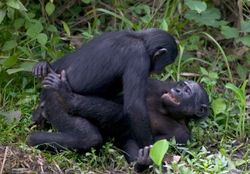From Nature:
 When the Congo River in central Africa formed, a group of apes was forever stranded on its southern banks. Two million years later, the descendants of these apes — the bonobos — have developed distinct social patterns. Unlike their chimpanzee relatives on the northern shore, they shun violent male dominance and instead forge bonds through food-sharing, play and casual sex. An 18-year-old female named Ulindi has now become the first bonobo (Pan paniscus) to have its genome sequenced. Scientists hope that the information gleaned will explain the stark behavioural differences between bonobos and common chimpanzees (Pan troglodytes) and help to identify the genetic changes that set humans apart from other apes.
When the Congo River in central Africa formed, a group of apes was forever stranded on its southern banks. Two million years later, the descendants of these apes — the bonobos — have developed distinct social patterns. Unlike their chimpanzee relatives on the northern shore, they shun violent male dominance and instead forge bonds through food-sharing, play and casual sex. An 18-year-old female named Ulindi has now become the first bonobo (Pan paniscus) to have its genome sequenced. Scientists hope that the information gleaned will explain the stark behavioural differences between bonobos and common chimpanzees (Pan troglodytes) and help to identify the genetic changes that set humans apart from other apes.
Distant relatives
Humans, chimps and bonobos all share a common ancestor that lived about 6 million years ago in Africa, when the human lineage splintered off. By the time that our Homo erectus ancestors were roaming the African savannah 2 million to 1.5 million years ago, populations of the common ancestor of chimpanzees and bonobos had been separated by the Congo River. Little and probably no interbreeding has occurred since then, says Kay Prüfer, a bioinformatician at the Max Planck Institute for Evolutionary Anthropology in Leipzig, Germany, who led the sequencing study. Comparisons of the bonobo genome and sequences of chimps from various populations showed that chimps living just across the Congo River were no more closely related to bonobos than were populations living as far away as Côte d’Ivoire. That implies that the separation was quick and permanent, says Prüfer.
Easy-going apes
Once the ancestors of bonobos had been separated from those of chimpanzees, they may have found themselves in a very different ecological world. North of the Congo River, the ranges of chimpanzees and gorillas overlap, so those animals compete for food. But no gorillas live south of the river, so bonobos face much less food competition, says Victoria Wobber, a comparative psychologist at Harvard University in Cambridge, Massachusetts, who has worked with bonobos including Ulindi. In the absence of competition, the ancestors of bonobos may have been free to forage a wider range of foods in large groups, and share the spoils freely. “When food is more consistently available, a lot of the aggression you see in chimps, you don’t need anymore,” says Wobber. Bonobos also treat sex as casually as a handshake, earning them the nickname ‘hippie chimps’. The sex is often non-procreative and can occur between pairs of the same sex. Chimps tend to have sex only when females are in estrous. “Instead of resolving their disputes aggressively, maybe they’re resolving them with sex,” says Wobber. And whereas chimpanzee groups are dominated by hyper-aggressive males, bonobo groups are less hierarchical and are often headed by females. Genetic discrepancies between chimps and bonobos must be involved in these behavioural differences, says Prüfer.
More here.

